Related Research Articles
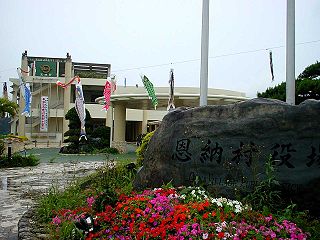
Onna is a village located in Kunigami District, Okinawa Prefecture, Japan.

The Yonaguni language is a Southern Ryukyuan language spoken by around 400 people on the island of Yonaguni, in the Ryukyu Islands, the westernmost of the chain lying just east of Taiwan. It is most closely related to Yaeyama. Due to the Japanese policy on languages, the language is not recognized by the government, which instead calls it the Yonaguni dialect. As classified by UNESCO, the Yonaguni language is one of the most endangered languages in all of Japan, after the Ainu language.

Awamori is an alcoholic beverage indigenous and unique to Okinawa, Japan. It is made from long grain indica rice, and is not a direct product of brewing but of distillation. The majority of awamori made today uses indica rice imported from Thailand, as the local production is largely insufficient to meet domestic demand, which has risen considerably in recent years.

The Tea Horse Road or Chamadao, now generally referred to as the Ancient Tea Horse Road or Chamagudao was a network of caravan paths winding through the mountains of Sichuan, Yunnan and Tibet in Southwest China. This was also a tea trade route. It is also sometimes referred to as the "Southern Silk Road" or "Southwest Silk Road."

Ryukyuan lacquerware is one of the chief artistic products of the Ryukyu Islands, and represents a form and style of lacquerware which is distinct from that of the surrounding cultures. Though distinct in its own ways, it is strongly influenced by Chinese, Japanese, and Southeast Asian modes.

The invasion of Ryukyu by forces of the Japanese feudal domain of Satsuma took place from March to May of 1609, and marked the beginning of the Ryukyu Kingdom's status as a vassal state under the Satsuma domain. The invasion force was met with stiff resistance from the Ryukyuan military on all but one island during the campaign. Ryukyu would remain a vassal state under Satsuma, alongside its already long-established tributary relationship with China, until it was formally annexed by Japan in 1879 as the Okinawa Prefecture.
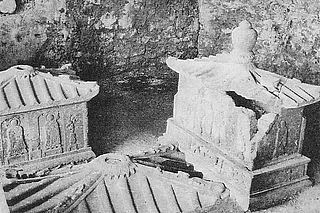
Eiso was a semi-legendary ruler of Okinawa Island. He was the founding monarch of the Eiso dynasty.

King of Ryūkyū, also known as King of Lew Chew, King of Chūzan, or more officially Ryūkyū Kingdom's King of Chūzan, was a title held by several lineages from Okinawa Island until 1879. It effectively started in 1372 when Satto greeted a Chinese envoy from the newly established Ming dynasty although his son Bunei was the first to be officially recognized as the King of Chūzan. However, the official Okinawan narrative traces the line of succession further back to the legendary ruler Shunten, who supposedly ascended to the throne in 1187. Another peculiar feature of the official Okinawan narrative is the notion of the single line of succession, instead of Chinese-style dynastic changes, even though they clearly recognized that several unrelated lineages had taken over the position.
Kamuiyaki ware (カムィヤキ), from Tokunoshima kamïyaki, is grey stoneware produced in Tokunoshima, the Amami Islands, Kagoshima Prefecture, Japan, from the 11th century to the early 14th century, or from the late Heian period to the Kamakura period.
Shimamono is a generic term for Japanese tea utensils produced outside Japan, Korea and China, mainly from Southeast Asia.

Ryukyuan pottery include earthenware and stoneware items that are traditionally made on the Ryukyu Islands in east Asia.

Mamoru Shō is an ethnic Ryukyuan, and the current head of the Shō family, the former Ryūkyūan royal family.
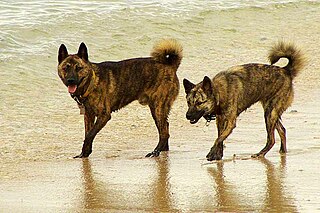
The Ryukyu dog is an endangered, medium-sized breed of dog indigenous to Okinawa, Japan. There were as few as 400 Ryukyu as of 2015. Unlike dogs such as the Kai Ken, the Ryukyu dog is not protected by the Nihon Ken Hozonkai, but instead is protected by the Ryukyu Inu Hozonkai.

The Second Shō dynasty was the last dynasty of the Ryukyu Kingdom from 1469 to 1879, ruled by the Second Shō family under the title of King of Chūzan. This family took the family name from the earlier rulers of the kingdom, the first Shō family, even though the new royal family has no blood relation to the previous one. Until the abolition of Japanese peerage in 1947, the head of the family was given the rank of marquess while several cadet branches held the title of baron.
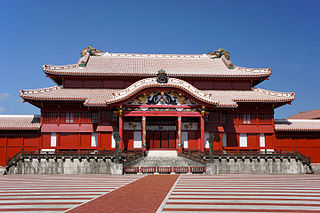
The First Shō dynasty was a dynasty of the Ryukyu Kingdom on Okinawa Island in the 15th century, ruled by the First Shō family under the title of King of Chūzan. According to the official history books compiled during the second Shō Dynasty, it lasted from 1406 to 1469. However, the official account is considered unreliable by modern historians because it contradicts contemporary sources.
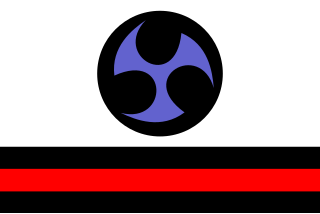
The flag of Ryukyu is a number of flags that represent the Ryukyu Kingdom, the Ryukyu Islands, and the Ryukyuan people.
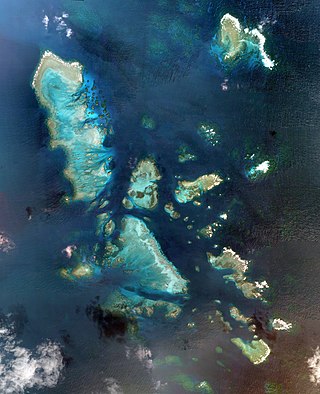
The Ryukyu Kingdom (1372–1879) on Okinawa Island used various writing conventions, all of which were markedly different from spoken registers. A unique feature of Ryūkyū's writing conventions is that in the Old Ryūkyū period (?–1609), it developed a predominantly kana writing convention that was based on sōrō-style Written Japanese but exhibited heavy Okinawan influence. After the conquest by Satsuma Domain in 1609, however, this style of writing was replaced by standard sōrō-style Japanese that was written predominantly with kanji. Other than that, Okinawan features were confined to the recordings of songs to sing, poems to read aloud, and plays to perform verbally, and did not have an autonomous status as literary writing. Instead, the samurai class of the kingdom was aligned with the literary tradition of mainland Japan that was established during the Heian period.
References
- 1 2 3 岡本弘道 (2011-03-31). "東アジアの茶飲文化 と茶業". 周縁の文化交渉学シリーズ1. hdl:10112/4396. Archived from the original on 2022-03-04. Retrieved 2022-03-04.
- ↑ 新垣力 (2007年). "沖縄における茶の湯の普及とその影響―14世紀~17世紀頃の考古資料からの検討". 南島考古. 第26号: 214.
- ↑ 伊波普猷 (1976). 伊波普猷全集·第10巻. 平凡社.
- ↑ 毛起龍 (2002). 思出草. 琉球大学法文学部紀要·日本東洋文化論集.
- ↑ 那覇市立壺屋焼物博物館, ed. (2011). 琉球陶器の来た道.
- ↑ 真栄平房昭 (2005). "琉球を中心とした東アジアにおける物流構造".
{{cite journal}}: Cite journal requires|journal=(help) - 1 2 "〈あけしのの会〉 泡を食べる? 琉球の茶道"ぶくぶく茶"を体験!". Archived from the original on 2021-01-28. Retrieved 2022-03-04.
- 1 2 安次富順子. "庶民が親しんだブクブクー茶 茶道は王朝のおもてなし". 琉球新報. Archived from the original on 2022-01-21. Retrieved 2022-03-04.
- ↑ "本校師生出席琉球茶道會 體驗精彩茶藝文化". 逢甲週報. 2017-04-10. Archived from the original on 2022-03-04. Retrieved 2022-03-04.